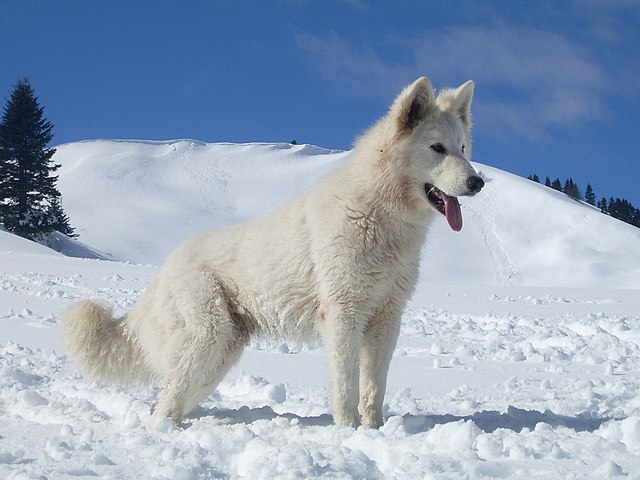The White Swiss Shepherd Dog’s history begins the same way as the German Shepherd Dog, as the two were once the same breed. Although the color white has been in the GSD breed since the beginning, it eventually became a disqualifying fault – one which not everyone agreed upon. Fanciers of the white variety wanted to keep the color alive and subsequently certain breeders focused on that particular color, which began to spawn a divergent bloodline. Several countries were focused on this project, but it was in Switzerland that the White Swiss was finally recognized by its kennel club in 1991 (under the name Berger Blanc Suisse) and eventually the FCI in 2011. Aside from color, fanciers focused on a specific type. Compared to the GSD, the White Swiss standard features a higher held head, a non-sloping topline, a difference in the front and rear assemblies, and a different gait. A long coat is also fully accepted in the standard.
Aside from his elegant appearance, the White Swiss Shepherd Dog is a large and powerful breed which is better suited to experienced owners. He can be somewhat protective of his owners and requires an person that understands how to manage this. He also may or may not be super excited about meeting strange dogs. Furthermore, he requires a house with a fenced yard and a medium amount of grooming – particularly the long coated variety, as he does shed. These are all aspects which novice owners may not be prepared to deal with.
The White Swiss is a versatile breed able to compete in a number of different sports and activities including herding (its original purpose), tracking, conformation, obedience, agility, dock diving, coursing, weight pull, drag racing, barn hunt and flyball. Some work as search and rescue dogs, others as therapy dogs, and a select few as service dogs. They are a breed that has a strong drive to work and enough energy to do that work all day! Athletic and capable, this talented breed also boasts high intelligence and easiness to train. It’s important to note that they are fairly sensitive and don’t learn well when trained overly harshly. They also can take a bit longer to mature psychologically than some other breeds of dog. Make sure that early and frequent socialization is part of the training plan. 
One might wonder if the Berger Blanc Suisse/White Swiss Shepherd (BBS/WSSD) is the same thing as a white colored German Shepherd Dog (GSD) or a UKC White Shepherd (WS). Here’s where things get confusing… yes and no. If one were to import a BBS/WSSD puppy and register it in AKC – they would be able to, except that the AKC would register it as a GSD. One could also import a BBS/WSSD puppy and register with the UKC, and the UKC would register it as a WS. But any potential offspring would not be able to be registered as a BBS/WSSD. It helps to think of each as a separate breed OR a separate bloodline, depending upon which organization is doing the classification. Most of the world does consider the BBS/WSSD to be a separate breed entirely but it is left to be seen whether or not the AKC eventually follows suit. It could be said that the breeds are genetically the same although the BBS/WSSD has a distinctly different standard. Clear as mud? Good.
The Swiss Shepherd is known for his kind and gentle temperament. He is excellent with children and makes a fantastic companion for both singles and families alike, although his large size and energy level may make him unsuitable for those with small toddlers. He is attentive, loyal and develops a strong bond – so much so that he will not thrive if not able to spend time with his owner/s. He should not be an outdoor-only dog, nor should live in a home where nobody is home for most of the day. He deeply needs his people and wants to be near them as much as possible.
White Swiss Shepherds need a lot of daily exercise – in some cases up to two hours – so that they don’t get bored. Otherwise they can become destructive and loud. The breed thrives when given tasks to do and truly need a job (or three) to occupy their time! This canine athlete is generally healthy and up for anything, although a few health issues do run in the lines. Prospective owners should make sure that breeders do their due diligence when it comes to hip and elbow dysplasia and joint issues, and owners should also make sure not to over-exercise young puppies in ways which can stress growing joints. When healthy, members of the breed tend to live for 11-13 years and will stay active and capable of greatness for a long time.
